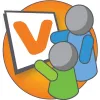Take a look inside 5 images
Vizzle
Pros: Ready-made, interactive activities make lesson prep effortless.
Cons: Slightly outdated content, limited feedback for students; navigating the dashboard can take some time.
Bottom Line: Thoughtful but dated tool helps with differentiation and progress-tracking for students with autism.
Teachers can use Vizzle to differentiate their class lessons for students. Built with universal design in mind, students can complete lessons on an electronic device of their choosing (fit to their own instructional level). Have students complete lessons at home, or use rotating stations in your classroom; Vizzle can be used as independent work for some students while you work with others in small groups.
Use Vizzle as a supplement to instructing IEP goals. Set a mastery level (e.g., 80%) to fit a student's IEP goals (e.g., reading consonant-vowel-consonant words) and easily chart their progress. Then bring the report to annual meetings or parent-teacher conferences. When analyzing student-specific data, use the filter option so that you can see which lessons the student completed in a week's time or even during one class period.
Vizzle is a platform that includes visual, interactive lessons for special education students and students with autism. Log in to the teacher dashboard to begin searching for lessons, which can be sorted by subject, grade, or type of activity. Topics include everything from ELA and math to speech therapy and life skills. Once teachers find a lesson they like, they can tag it, preview it, add it to a student's education plan, or save it to My List. Once they're added to the roster, lessons can be assigned to multiple or individual students.
With Vizzle, teachers can set goals for students along with customized mastery levels (so that students must reach a certain percentage before moving to other content areas). Detailed reports show student progress toward mastery. Feel free to customize each student's play preferences, and add accommodations such as text to speech, color, theme, and visual reinforcer. Filter data to include start and end dates, times, and more. A separate Vizzle Player lets students interact directly with the online lessons that teachers have added to education plans.
Whether students use Vizzle individually or at home for additional practice, the platform is best used for supplemental instruction. Because the website includes thousands of lessons, students and teachers can narrow in on specific areas, like single-digit addition. Once students complete lessons, data is automatically collected. The best thing about Vizzle is that it collects the data seamlessly and presents it in an easy-to-read graph. Filtering the student data helps teachers see if their students are generalizing content to their core academic areas, performing to expectations in different class periods, or even if they're able to independently complete lessons during a certain time of day.
While the data is great, the content in Vizzle could use a bit of sprucing up; the visual reinforcers will be less engaging to older students. Assessment is limited to matching and multiple-choice questions, and there's little help or feedback given to students if they get wrong answers. Vizzle is best for targeting specific student needs, and it may help provide reinforcement to students with autism or other special needs if teachers are able to use the data wisely.













